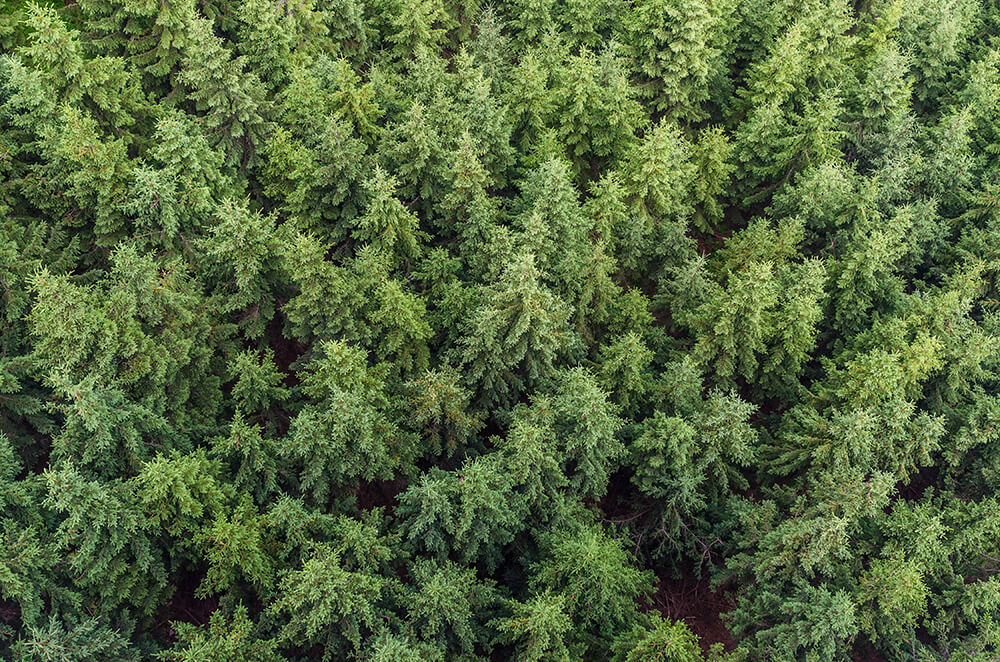The mystery of mast years comes from tree communication

If you’ve been walking through the woods this late summer, you’ve probably noticed acorns in the treetops, hanging from low branches, littering the ground. Acorns, the fruit of oak trees, are the most visible of our tree seeds, but they’re just one example of “mast.”
“Mast” are the fruits, seeds and nuts of trees and shrubs, which are eaten by wildlife. “Hard mast” are nut-like seeds, such as acorns, hickory nuts, beech nuts and beaked hazelnuts (our native hazelnut). “Soft mast” are fruits and berries like blackberries, blueberries and apples. While there are many green plants, insects and other seasonal treats to eat in the summertime, many wildlife species rely on mast in the late summer and fall to fatten up for the winter or to migrate.
Mast-producing trees have a love-hate relationship with wildlife—they may rely on birds and animals to disperse their seeds but can suffer if too many of them are eaten or destroyed. An example of this is the acorn. While squirrels, other mammals and even blue jays help spread them far and wide, acorns are such a valuable food source that few of them ever get to sprout. In the two years that it takes red oak acorns to develop and mature on the tree, about 50 percent of them are parasitized, eaten or otherwise destroyed. Once they fall to the ground about 98 percent of them succumb to a similar fate, eaten by deer, bear, squirrels, turkeys and pretty much everything else in the woods.
Trees that produce mast, like oaks, spruces, maples, ash and pines, have developed a clever strategy for dealing with this. Instead of producing mast every year they produce it at irregular intervals, withholding production for several years and then producing a massive abundance of seed. This method allows trees to “starve” the predators of their seed for several years, lowering their populations, and then overwhelm them with more mast than they can eat. The intervals at which these “mast years” occur varies by species, from red oaks (every two to three years) to sugar maple (every two to five years) to red spruce (every three to eight years).
The key to this strategy is coordination—it works only if everyone does it at once. How tree species coordinate mast years is still somewhat of a mystery, but this “synchrony” is probably aided by some combination of chemical signals passed through the air or through underground root/fungal connections and weather cues. In some parts of the world, mast coordination between trees of a given species may stretch for hundreds or even thousands of miles.
Populations of many wildlife species reliably spike following a mast year. A local example of this is when sugar maple, white pine, red oak, red and white spruce and others all “masted” simultaneously in 2017, leading in 2018 in Chittenden County and beyond to an extreme abundance of squirrels. While lots of mast in the woods means that our wildlife will be in better shape going into the winter, there are also unfortunate side-effects; mast years increase the populations of rodents and deer, which transport and host ticks and contribute to the spread of tick-borne diseases.
Foresters are on both sides of this push-pull between wildlife and mast-producing trees. On one hand, part of our job is to manage forests for great wildlife habitat. At the same time, we rely on natural regeneration—rather than planting—to create future generations of trees, and mast are our future oaks, maples, pines and spruces. Human-created problems like invasive plants and the overpopulation of deer in much of Vermont challenge our ability to regenerate healthy, resilient forests, and so we often go to great lengths to help acorns and other mast make it past the critters to become trees.
Consider “releasing” the healthiest mast trees on your property by cutting less-healthy trees on two to four sides of them. This will allow their crowns to expand, which will help them produce more mast—meaning more food for wildlife and an increased chance of those seeds reaching the ground to sprout. From a forest management perspective, timing timber harvests with mast years can help regenerate mast trees like red oak and white pine by creating conditions amenable to the regeneration of these species, like gaps in the canopy and disturbing the “duff” at the surface of the soil.
Ethan Tapper is the Chittenden County forester. He can be reached via email, by phone at (802) 585-9099, or at his office at 111 West Street, Essex Junction.

